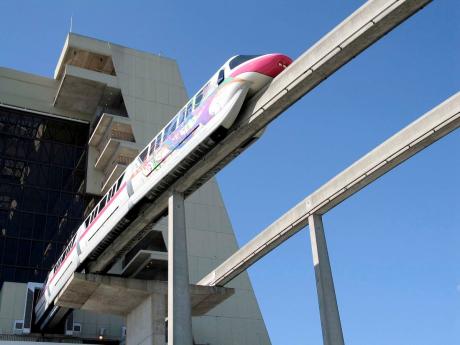Editorial | Consider monorails
This newspaper repeats a suggestion that it made repeatedly in recent times regarding public transportation. End the finger-in-the-dyke approach to the problem in favour of a broad, imaginative, multi-sectoral perspective on solutions.
In that event – and taking into account the city’s worsening traffic congestion, its limited space for new roads or the expansion of existing ones, and the necessity of an efficient mass-transit system – a monorail for Kingston must be part of the policy discussion.
The need for thoughtful, integrated transport policy has never been far away. It has, however, been brought back to the agenda as an urgent national issue with the Government’s disclosure last week that taxpayers will have, in the coming fiscal year, to shore up the state-owned Jamaica Urban Transit Company (JUTC) to the tune of J$16 billion. That is J$2 billion, or 14 per cent, more than projected for the current fiscal year that ends on March 31. That will bring total taxpayers comfort to the company over five fiscal years to more than J$57 billion.
The Gleaner doesn’t, merely on its face, begrudge taxpayers support for the JUTC, which serves the Kingston Metropolitan Area (KMA), which stretches to sections of the parish of St Catherine to the northwest. After all, efficient public transportation systems are important to the functioning of large cities, especially those that are crucial hubs for national economies, such as Kingston is. Except that the JUTC – but for a brief period after its launch nearly three decades ago – is, by any measure, a badly run and inefficient company.
That would be bad enough if with its preferential treatment (including being allowed to charge significantly lower fares) it transported more of Kingston’s commuters than the city’s route taxis, which generally operate with unbridled recklessness.
Commuters risk the daredevil taxis in large part because they have little confidence that JUTC buses will arrive, or that they will get them to their destinations in a timely manner.
PIECEMEAL AND UNIMAGINATIVE
Unfortunately, attempted fixes to the transport problems of the KMA, where nearly half of Jamaica’s population lives, have been largely piecemeal and unimaginative. For instance, for eight years route taxi fares were officially frozen and when they were granted an increase in 2021, a portion was withheld. Further, allowing great numbers of route taxis into the systems was seen as a safety valve against unemployment.
This strategy is incapable of delivering a transportation system required of the modern, 21st century economy, while also facing the menace of global warming and climate change.
It is against this backdrop that we urge the development of medium to long-term policy for public transportation that plans for where Jamaicans will live over the next half a century, how they will commute and the way commuters systems will affect how they work and pursue leisure. This understanding will dictate where and what kinds of roads are built and how transportation systems, including private vehicles and mass transits, are regulated.
Already, more than 600,000 vehicles are registered in Jamaica. In 2022, licences valued at US$500 million were issued to importers. Of the more than 21 million barrels of oil imported, at a cost of over US$2 billion, a third was used by ground transportation. Hundreds of millions of dollars more are spent on vehicles’ spare parts and to otherwise keep these vehicles on the roads.
It is clear, too, from the congestion and traffic jams, that the island’s cities and towns are fast running out of space for these vehicles to travel. Efforts to break the gridlocks by widening existing roads or building new ones are, in short order, overcome by increased traffic.
NEW POLICY APPROACHES NECESSARY
New policy approaches are necessary. In the short to medium term, maximising the use of existing thoroughfares and encouraging the lessening of vehicles on roadways are critical.
It is in that context that The Gleaner suggests that the Government seriously explore the feasibility, via public-private partnership arrangements, of constructing monorail or light rail systems along key thoroughfares, say from Manor Park in the north, to Cross Roads in the south, a distance of around eight kilometres. Or along the nine-kilometre stretch from Papine in the east, along Hope Road, to Three Miles in the west, via Hagley Park Road.
Monorails have the advantage of being able to run on high concrete beams above city streets, with no interaction with, and little disruption of traffic at road level, even when being built. Depending on their design, they can move significant numbers of people quickly. They are in that respect good for cities.
But monorails are not necessarily inexpensive, in terms of direct cost, to develop. By this newspaper’s reckoning, the cost of a Manor Park to Cross Roads system would probably be the same as the US$700 million China Harbour Engineering spent on the tolled North-South Highway of more than 40 kilometres.
However, a feasibility analysis would take into account the monorail’s wider economic and social impact, including when linked to the proposed larger transport policy.

